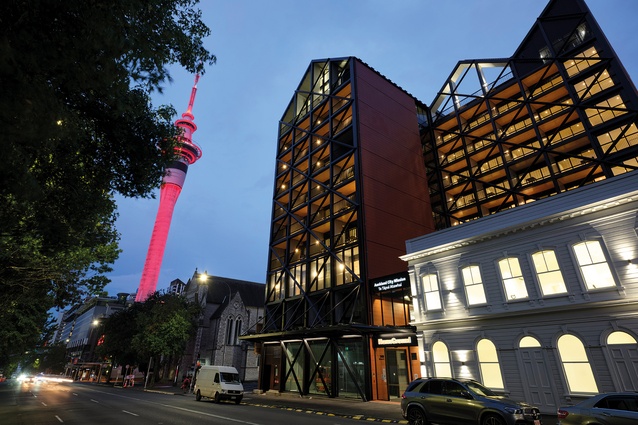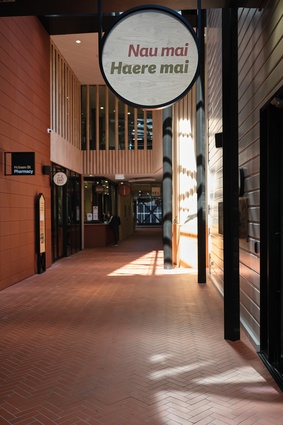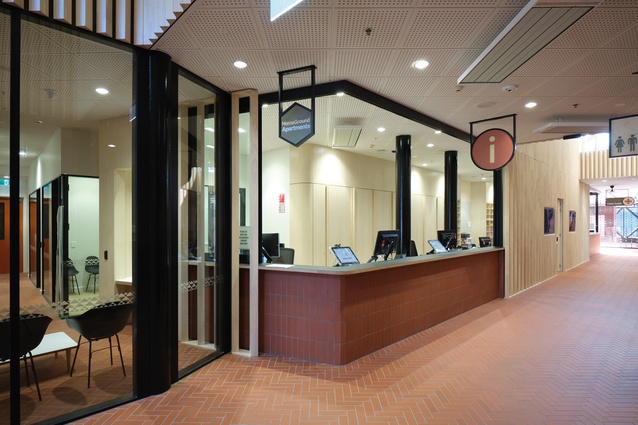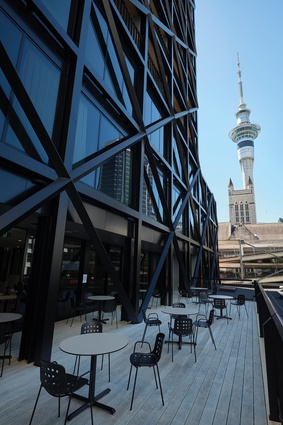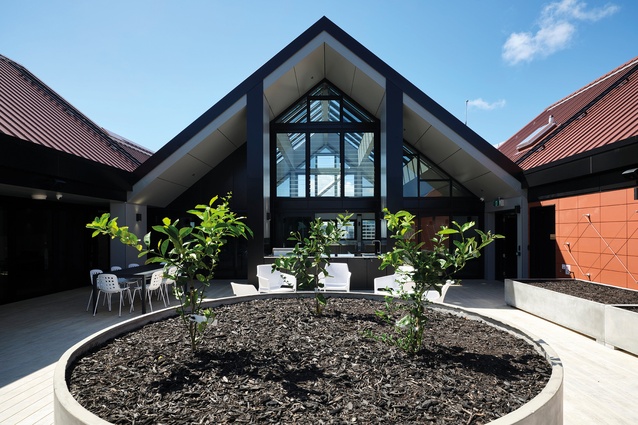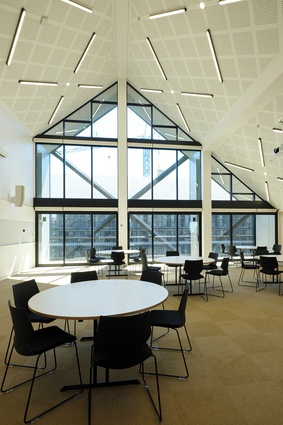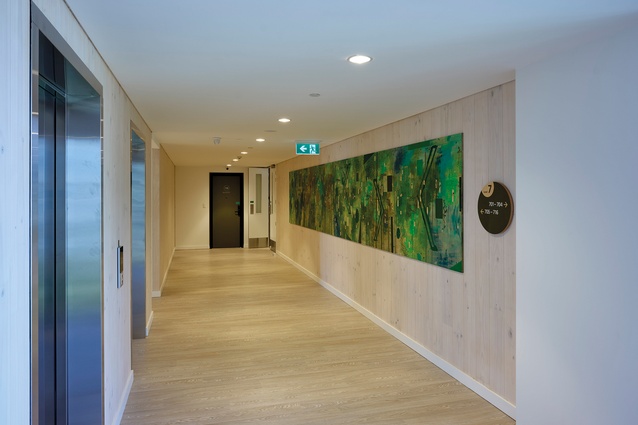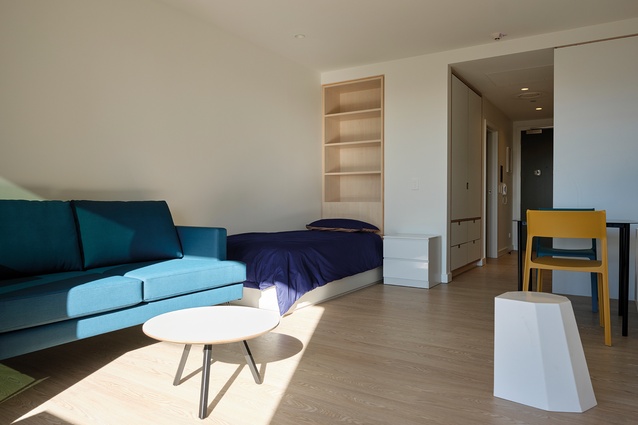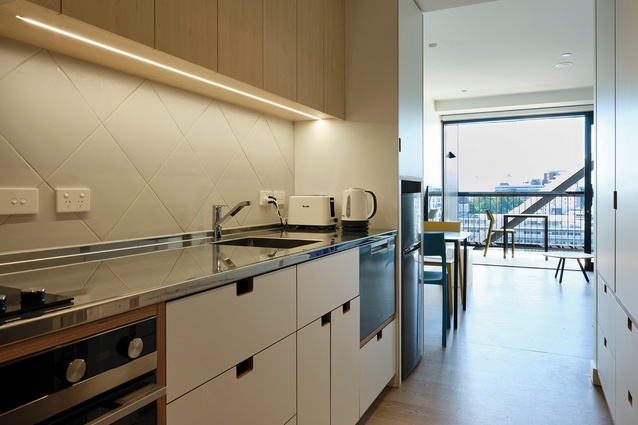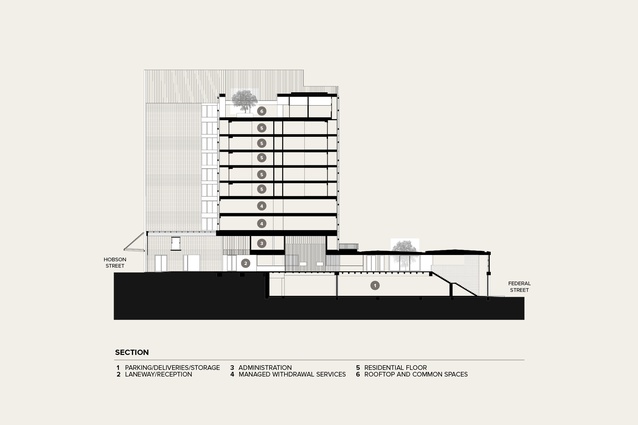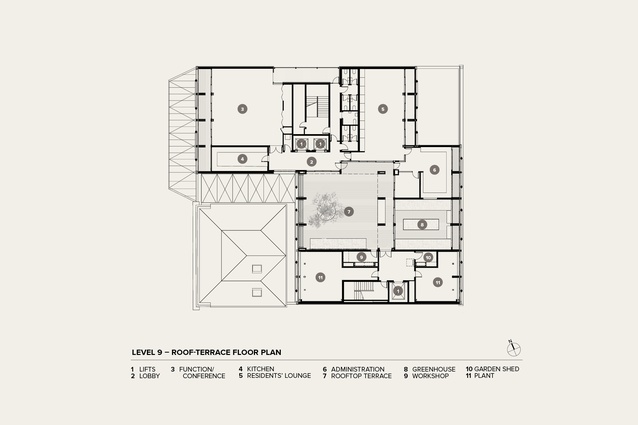The new net goes fishing
In the Auckland City Mission’s HomeGround, Stevens Lawson Architects has created a building of national significance, designed to support our most vulnerable with compassion and dignity. Bill McKay investigates.
The whakataukī ‘Ka pū te ruha, ka hao te rangatahi, the old net is put aside, the new net goes fishing,’ isn’t about catching things, the interpretation many of us in Aotearoa New Zealand would leap to. Even though a few people on the street told me this building’s steel lattice frontage looked a bit like a cage, it is quite the opposite. The proverb relates to how the young replace the old and bring with them fresh ways of doing things and new ways of navigating issues. And this new building certainly does that.
The City Mission has been providing health and social services to marginalised Aucklanders since the 1920s, mostly operating from a 19th-century building, formerly the Prince of Wales hotel. This new, purpose-built structure replaces the ad hoc architecture that has frequently constrained the Mission’s activities and interaction with clientele and the community. It is truly a complex, providing a wide variety of spaces for its inhabitants, accommodating more than 100 staff members and providing 80 small apartments, mostly for singles, but a few larger ones as well.
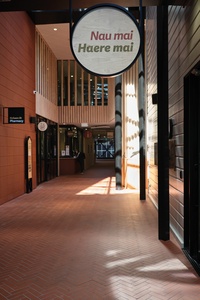
The most striking architectural gesture in plan is the provision of a public laneway from Hobson Street through to a newly formed shared space in Federal Street. By inviting informal interaction through this casual short cut, the building inverts the centuries-old approach of internalised charitable buildings: ‘poor houses’ where the problem of the poor is moved ‘off the streets’ and hidden away. This laneway is also atrium and lobby; the public can access an eventual café, shop at a pharmacy, walk past the reception counter and lifts, and glimpse various spaces and facilities – even use some of them. A variety of screens and grilles allows for separation of spaces at any time so that the local community and businesses can book spaces for use during the day or evening for events, meetings and so on. There are also outward-oriented spaces on Federal Street that serve the same role. This promotes a sense of the complex as being entwined with the community, not separate, and we will talk about that again once we have been around the building and come back to that Hobson Street façade, the great lattice of lalava (lashing) that symbolises entwinement and enmeshing from Pacific and Māori points of view.
The design of the laneway allows it to be closed off, separating circulation and functions overnight, and other spaces in the building are also available for public use; this can provide additional income to the Mission. What is striking about this building, particularly on the first few floors and up top, is the generous provision of facilities and resources. There are creative spaces with musical instruments, art and carving spaces, therapy spaces, and a small chapel-like space where you may say goodbye to that mate you met on the street, lying in state as they would in a tangi. There is good attention to tikanga through various touchstones of all kinds; HomeGround will be home ground for many who are itinerant or homeless, not just for those living here.
The first floor is largely a staff area: workplaces and indoor and outdoor areas in which to take a break. I like the way it bridges the laneway in a couple of places, another layer woven into the warp and weft of the building. There is plenty of space to work and the usual retreats and quiet spots of today’s open plans; but, crossing back and forth through the atrium space, one is always conscious of people below and purpose. The next few floors are dedicated to health purposes, such as detox and more-extreme circumstances where people need to be helped not to harm themselves or others. The attention to detail in these spaces is a level above what most of us would think of, helped along, of course, by various Health Board and other guidelines, but the design necessary to ensure the spaces retain a comfortable rather than clinical ambience is skilful. And, in our tour of the building, I haven’t yet mentioned the Federal Street ground-floor basement. There is stacked parking and a few other things you would expect but a charity never knows what windfalls will arrive so there are spaces here to enable anything from daily bread delivery to onsite butchery. There is also discreet parking for an ambulance, and a lift to and from the medical areas. The public may perceive this place as something like a budget hotel or hostel but the guts of the place are much more complicated than almost any other type of building I have seen, to enable all the facilities to run efficiently but with respect for all and discretion where needed.
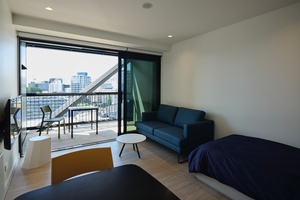
Going up: most of the rest of the floors are dedicated to accommodation. Each level is ascribed a theme and a colour, such as Rangi in blue or Ngahere in green, and lovely long artworks on the landings specifically made and donated by John Reynolds. The rooms, mostly, include single beds along the lines of a hotel room; each one has an en suite, a balcony, its own laundry and a kitchen, fully furnished from TV to cutlery and cooking utensils. Yours for life, if you want it (and behave yourself) and a small rent is paid from your welfare entitlement. In addition to your balcony, there are some common outdoor areas on each level if you want a change of scenery or a chat with another resident.
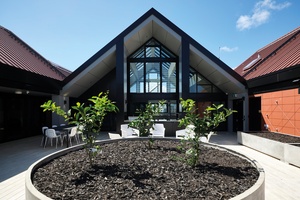
And, finally, as we reach the top, this ninth floor is dedicated to common spaces or what can also be called extended living. Apartment buildings shouldn’t be like hotels; they should be like cruise ships. Your small, affordable accommodation can be like a cabin in which you make a small snack, sleep, shower and so on. The real action is elsewhere: individual and community activities down in the hull, and casual interactions and social get-togethers on the upper decks. We are seeing the medium-density apartment builders Ockham doing this kind of thing and HomeGround is along similar lines. The pitched roofs and pergolas on the top floor give the spaces, indoor and out, a nice homely, attic-y atmosphere. There is a common room with computers, a big kitchen, and a greenhouse and other planters for learning gardening and growing food. There is also a space that can be used for various purposes – and can also be booked by the local community or businesses.
This is an extremely complex building, 15 years in the making, partially thanks to the odd global financial crisis affecting fund-raising. The passer-by may not fully appreciate this but do take the opportunity to walk through that laneway: a small step to appreciating this huge achievement. That diamond lattice on the front – safety net, cage, whatever – is also fully functional; the building is concrete and steel for the first few floors but mass timber after that. These engineered-timber panels are left bare in stairwells and the whole system was, I am told, very quick and efficient to put together. That’s another very interesting aspect of the building I can’t squeeze in here but I sure hope Stevens Lawson can give us a few CPD sessions to pass on what they have learned. But a stack of timber panels can be like a house of cards: strong in the depth of the structure but needing to be laced together in the lateral dimension – across the body. It’s like fastening a shirt or shoelaces, or buttoning up against foul weather. I am reminded of a James K Baxter poem, written when he was at a bit of a nadir: “oh early in the morning / I wake up… with a mouth like old leather / then I pull on my strides and a belt and a coat / to hold myself together…”
I often think of this poem when I get up each day. A close member of my family died on the streets. His construction business had been screwed over on a big project by a client who never paid. He chose to give away worldly possessions and pressures, to no longer be a human resource unit in the service of capitalism. He chose to walk the streets as an itinerant and why not? We frequently found him homes and jobs but, after a few weeks, he would give them up and walk away. He would drop in at our house and spend a week refuelling, reconnecting. He also loved the library and the City Mission for a similar reason. I have a great deal of respect for his attitude. Most of the conversations I have these days about society’s problems, over too many glasses of wine, of course, end up with me thinking: f***ing capitalism.
Will this new complex solve a problem for everyone homeless or on the streets? Of course not – there are as many reasons for homelessness as there are people. Will this new building help those in need, those who assist them or, even, just engage for a moment those of us who usually walk on by? Yes. RIP Mike; you would have loved this building, this new home ground.

